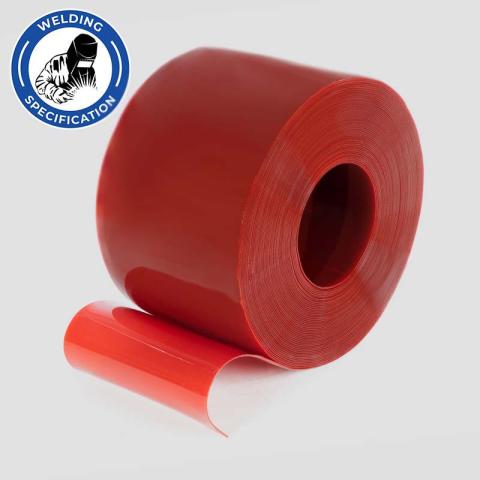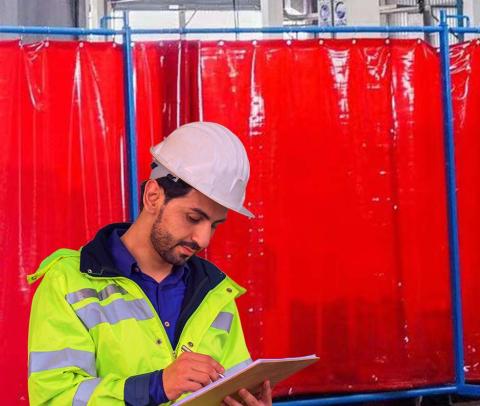Screenflex PVC helps teams stay safe and companies stay compliant - while keeping welding zones visible, contained, and under control.
In manufacturing and metal fabrication, welding is a critical process—fusing metals, building infrastructure, and powering production across sectors. But it also brings real hazards.
Workers face daily exposure to arc flashes, molten metal, UV radiation, and airborne fumes—each carrying the risk of serious injury or long-term health effects.
Today’s workplaces need more than just personal protective equipment. They need engineered materials that reinforce safety standards without slowing operations. That’s why Screenflex Welding PVC has become a trusted choice for manufacturers seeking both safety and efficiency.
As a global leader in flexible vinyl technologies, Extruflex has created a material specifically designed to withstand welding environments while ensuring compliance and protection.
What Is Screenflex Welding PVC?

In industrial settings where welding is part of daily operations, safety and material performance are non-negotiable. While there are many flexible PVC products on the market, not all are designed to withstand the unique hazards associated with welding. At Extruflex, we developed Screenflex specifically for this purpose.
Unlike standard or Anti-UV PVC grades, Screenflex is engineered to deliver critical protection and durability in active welding zones. Its formulation and optical properties are tailored to meet the demands of workplaces where compliance, visibility, and personnel safety are essential.
Here’s why Screenflex is the correct and most important PVC grade for welding applications:
- UV and Blue Light Filtration – Screenflex filters the harmful rays produced by welding arcs, helping protect the eyes and skin of nearby personnel.
- Flame Retardant – Designed to resist ignition and self-extinguish when exposed to sparks, reducing the risk of fire in high-heat areas.
- Durable and Flexible – Withstands impact and frequent handling, making it ideal for both fixed screens and mobile enclosures.
- Clarity and Consistency – Maintains visual control between zones without compromising safety or protection.
While Anti-UV PVC may be used in some light-screening applications, it does not meet the same flame resistance and light filtration standards required in welding environments. Screenflex is purpose-built, tested, and trusted for this use — and is the clear choice for manufacturers, fabricators, and contractors looking to safeguard their operations.
Whether installed in welding booths, suspended partitions, or mobile barriers, Screenflex delivers peace of mind where it matters most.
Why Welding Requires a Specialised PVC?

Screenflex is designed to address the three primary risks in welding environments: harmful light, extreme heat, and toxic fumes.
1. UV and Blue Light Protection
Arc welding emits intense ultraviolet (UV) and high-frequency visible light—enough to cause eye injuries like photokeratitis ("welder’s flash") and skin burns. Standard transparent materials offer little protection. Screenflex is tinted to block those rays and independently tested to meet or exceed key safety standards such as ISO 25980 (internationally), EN 1598 (in Europe), and AWS F2.3 (in the United States).
2. Fire Retardancy in High-Heat Zones
Welding environments generate high temperatures, flying sparks, and molten metal fragments. Screenflex is not only flame retardant but also self-extinguishing. It has been tested and confirmed to meet the strict requirements of ISO 25980 and AWS F2.3.
3. Smoke and Fume Containment
Welding processes emit fumes and airborne particulates that pose respiratory risks. Installing Screenflex partitions helps localise these emissions, contributing to better indoor air quality and facilitating compliance with health and safety regulations.
Key Benefits of Screenflex Welding PVC
Whether you're setting up a welding booth or outfitting a full production floor, Screenflex is built to perform and protect.
- UV/IR Light Filtering: Maintains visual supervision while reducing eye and skin exposure.
- Fire Safety Compliant: Meets international standards for flame resistance and safety signage.
- Durable and Long-Lasting: Resistant to cracking, tearing, and chemical degradation—even in high-traffic zones.
- Flexible Installation: Available in multiple sizes and thicknesses; compatible with most hanging systems.
- Custom Configurations: Ideal for everything from compact welding booths to full-facility segmentation.
Where Screenflex Is Commonly Used

Because it’s tough, adaptable, and compliant, Screenflex fits into nearly any welding workflow—no matter the industry. It makes it easy to section off welding areas, manage fumes, and keep workers safe—without disrupting operations.
Shipbuilding and Marine Yards
In large-scale ship construction and repair, welding operations often occur in close quarters and across multiple work zones. Screenflex helps create defined, safer welding areas on decks, in hulls, and within confined engine spaces.
Automotive Manufacturing and Repair
From high-volume welding lines in car factories to precision work in body shops, Screenflex contains sparks, UV radiation, and fumes – protecting surrounding workers and sensitive equipment.
Metalworking and Fabrication Plants
Facilities handling cutting, grinding, and joining of metal components count on Screenflex to divide workstations, reduce cross-contamination, and shield bystanders from welding hazards.
Technical Training Centres and Welding Schools
In training environments, instructors need clear visibility—but never at the expense of safety. Screenflex allows them to oversee student work while shielding the area from flash and spatter.
General Industrial Manufacturing
Any site that integrates welding into its process—whether producing machinery, infrastructure components, or fabricated goods—benefits from the structured safety Screenflex provides.
Meets the Standards That Matter
Screenflex is built to meet major global safety standards for welding curtains and screens.
ISO 25980 – Health and safety in welding and allied processes: Ensures that transparent welding curtains offer appropriate protection from harmful radiation.
EN 1598 – European standard for light-transmitting welding screens: Verifies that materials filter UV and blue light while allowing safe visibility.
AWS F2.3 – American Welding Society guidelines for welding screens and curtains: Establishes criteria for physical properties and fire resistance in U.S. facilities.
Build a Safer Welding Environment with Screenflex
In shipyards, repair shops, and fabrication plants, Screenflex by Extruflex is the go-to solution for professionals responsible for welding safety. Operations that need to keep welders protected and processes moving choose Screenflex for its real-world reliability.
If you're planning a new installation, updating existing safety infrastructure, or simply exploring the best materials for your environment, our team is here to help.
Contact Extruflex to request technical data, product samples, or expert recommendations tailored to your site’s needs.
